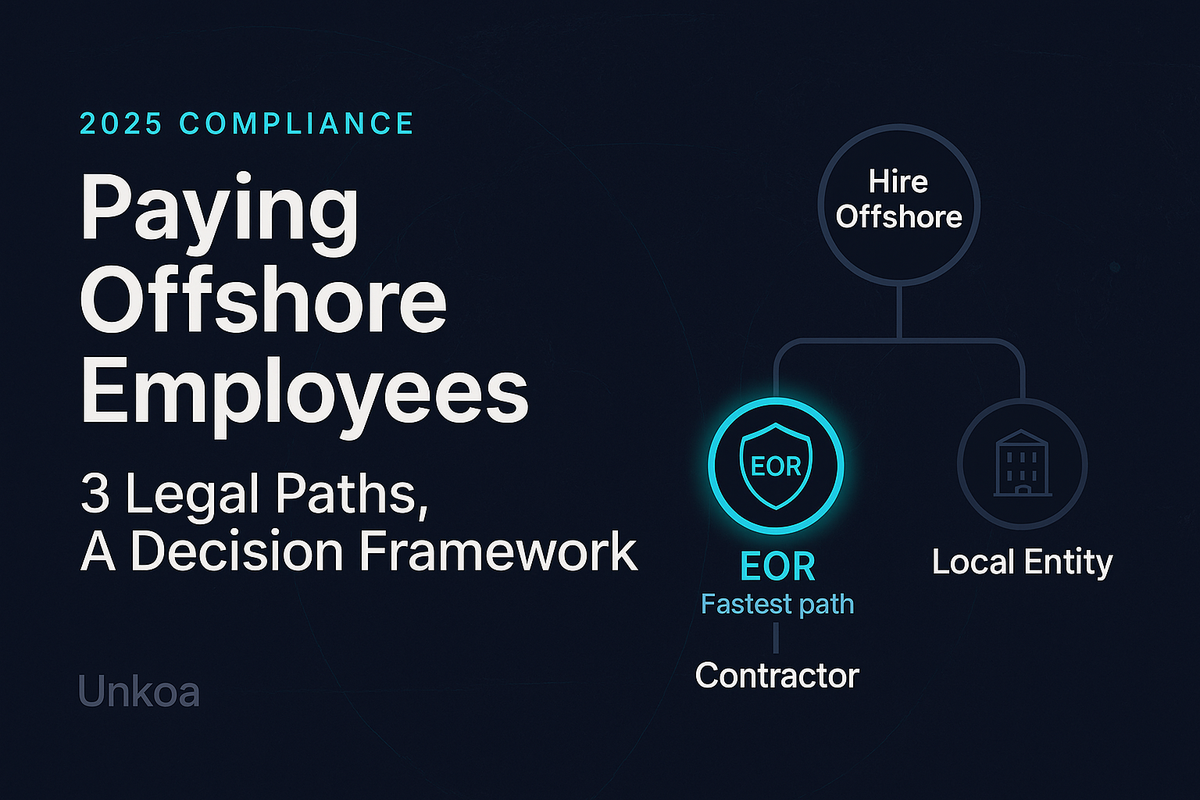How To Pay Offshore Employees in 2025: 3 Legal Paths, A Decision Framework, And The Fastest Way To Stay Compliant

Hiring across borders is easier than ever, paying people correctly is not.
Every country has its own rules for payroll tax, social security, benefits, contracts, and terminations.
Get any of it wrong and you risk fines, back taxes, or blocked hiring.
This guide breaks down the three legal ways to pay offshore teammates, gives you a 60-second decision framework, and shows why an Employer of Record (EOR) like Deel is often the fastest, lowest-risk path.
The problem in plain English
- Local payroll taxes and social contributions
- Statutory benefits and paid leave rules
- Currency and payment rails
- Data protection and payroll reporting calendars
- Worker classification tests and permanent establishment risk
Misclassifying a full-time worker as a contractor can trigger penalties and back taxes in the United States, and similar issues elsewhere.
The Society for Human Resource Management outlines how quickly misclassification costs can escalate.
Permanent establishment risk is separate from payroll.
If your activities in a country look like a fixed place of business or a dependent agent, local tax authorities can treat you as taxable there.
The OECD Model Tax Convention defines when and how income is attributed to a PE.
The three legal ways to pay offshore employees
1) Open a local entity and run domestic payroll
When it fits: You plan multi-year growth in one country, need local IP ownership, visas, or deep local presence.
Trade-offs: Months of setup, ongoing filings, legal and accounting overhead, local HR expertise required.
2) Engage the person as an independent contractor
When it fits: Short projects or genuinely independent work.
Risks: If the worker operates like an employee, for example fixed hours, under your direction, core role, you can face misclassification claims and retroactive employer taxes.
Use sparingly for true freelancers.
See guidance from SHRM for context.
3) Use an Employer of Record
What it is: An EOR becomes the worker’s legal employer in-country, handling compliant contracts, payroll, tax withholdings, statutory benefits, and routine HR administration.
You manage the day-to-day work.
Platforms like Deel provide this in 150 plus countries and let you hire in days without opening a local entity.
Spin up compliant employment in days, not months.
Payroll, taxes, benefits, and local contracts handled in 150 plus countries.Hire with Deel No long-term contract, scale month to month
A 60-second decision framework
- Headcount in one country this year: 1 to 3, or 4 plus
- Speed required: days or weeks versus months
- Risk tolerance: low or high for misclassification and local compliance
- Need for local presence: visas, local IP, public tenders
- Budget for setup and ongoing admin
Outcomes:
- Mostly 1 to 3 hires, need speed, low risk tolerance: choose EOR via Deel.
- Many hires in one country and long horizon: open a local entity, possibly migrate off EOR later.
- Short, project-based work by true freelancers: use contractors with clear independence and IP terms.
What to budget, realistically
- Gross salary
- Employer social contributions and local taxes
- Statutory benefits, for example health, pension, paid leave, 13th-month where applicable
- Payroll platform or provider fees
- Currency conversion and payment fees
- Occasional legal, immigration, or off-cycle adjustments
Global mobility adds layers like split payments, business travelers, delayed adjustments, and treaty interactions that require clean payroll records and audit trails.
See PwC’s global mobility payroll guidance for common pitfalls and controls.
Compliance corner, the big three risks
1) Worker classification
Design roles, contracts, and working patterns to pass local tests.
When in doubt, use an EOR via Deel to reduce misclassification exposure, and cross-check with SHRM resources.
2) Permanent establishment
Sales authority, contract signing, or a fixed place of business can trigger corporate tax in the host country.
Coordinate with tax advisors and keep roles, contracting, and revenue attribution clean.
Review the OECD guidance on permanent establishment.
3) Social security and the 183-day effect
Track travel days and residence tests.
Totalization agreements and certificates of coverage help you avoid double social security contributions.
The U.S. Social Security Administration explains when and how to obtain these certificates.
Split payroll, in one minute
For some assignments, employers split pay between home and host currencies.
This can stabilize take-home pay, simplify parallel payroll reporting, and align with retirement participation rules.
Use carefully and only where supported by local rules and your platform.
PwC notes split payments and dual reporting as common features in cross-border programs.
Tooling snapshot, choose by fit, not hype
| Method | Time to hire | Compliance burden | Upfront setup | Countries | Best for |
|---|---|---|---|---|---|
| Local entity | Months | High, all in-house | High | One country at a time | Large or permanent presence |
| Contractors | Days | Medium to high, misclassification risk | Low | Any | Short, independent projects |
| EOR via Deel | Days | Low, provider handles it | Low | 150 plus | Fast, compliant hiring in many countries |
Use an Employer of Record when you need speed and compliance across borders.
Local payroll, filings, and statutory benefits are handled for you.Start with Deel
Step by step, your first offshore hire in a week with an EOR
- Pick the country and salary band
- Generate a compliant contract in the platform
- Collect local IDs and tax forms
- Enroll statutory and optional benefits
- Set payroll schedule and currency
- Run first payroll, taxes and contributions filed locally
You can repeat this in multiple countries without opening entities, then decide later if and where to establish a local company once headcount justifies it.
Try it now with Deel.
Short notes on alternatives
Remote: a global EOR that emphasizes owning more of its payroll rails across 100 plus countries, suitable if you want strong in-house infrastructure.
Rippling: combines HR, IT, and global payroll, useful if you already run your HR stack there and want tight system integration.
If you need a quick, low-risk start in multiple countries, an EOR like Deel is usually the speed option.
If one country becomes a hub with bigger teams, you can migrate to a local entity later.
FAQs
Is an EOR legal in my country?
EOR is a well-established model.
The provider becomes the in-country legal employer and runs compliant payroll and benefits.
Always verify local nuances before hiring at scale.
Do I still have to worry about permanent establishment if I use an EOR?
Yes.
PE is about your company’s business presence, not payroll mechanics.
An EOR reduces employment risk, it does not erase PE outright.
Review the OECD PE framework and consult advisors.
How do I avoid double social security?
Use totalization agreements and request certificates of coverage.
The U.S. Social Security Administration explains the process.
What about 183-day rules?
Many countries treat individuals as tax resident after around 183 days in a period, which can change withholding and reporting.
Track days carefully and plan assignments with tax support.
Ready to move
Hire in days, not months, with an EOR.
Start your first compliant overseas employment with Deel.





